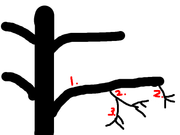My wife found this real interesting video yesterday from a mangosteen research station in Chantaburi, Thailand. They have been researching the benefits of grafted mangosteen to replace seedling trees. Was pretty cool. My wife translated and I took notes the best I could. So read my notes first and then try to follow along with them with the video. So here's my notes with video at the end.
Chantaburi mangosteen research and development.
Main guy talking is head of research. Starts off talking about mangosteen export. In 2007…47,232 tons were exported. In 2011…109,200 tons. China is main customer.
Said there is not a problem marketing mangosteen…always be a market for them. Never any issues with plants or orchard.
Thailand is approximately 160,000 acres planted with mangosteen. Each acre averages 5500lbs of fruit. Enough for the demand/supply for now. More and more land will open up and demand will also rise.
Picking and labor main concern/problem. Have to climb the trees to pick the fruit. If a worker grabs a fruit too hard, it can bruise it causing the rind to harden and also lower the quality of the fruit. So their #1 focus is picking.
All trees in background are seedling trees. Tall. Normal for seedlings.
Around the 7:20 minute mark. Quality pickers are high cost. 20-25% of their costs go to labor. Very difficult to find good labor. When first wave of fruit comes on, this gets the highest price so really need to get the fruit out there. Almost like corporate headhunters for good pickers!
8:49 minute. He said he is talking to an engineer to design a mechanical picker. But in the meantime, alternatives must be found. Lower trees mean fruit is easier to pick, less money for labor.
So they’ve been researching many years on best methods to graft mangosteen. If you pick the wrong scion, the results will not be what you want. The scions must be taken from the second or third branches of a branch. See below:

Grafting with these scions will keep the tree low and spreading which is desired. Not growing up and tall.
10:00 minute. Guy asked him if there was a difference in production. They are still collecting data on this but he feels that you can plant more trees per same size of area as seedlings and yield should be the same.
10:40. Shows grafting mangosteen. The woman here is a specialist. Describes the grafted plants as growing a little more than 2 meters in height.
11:11 minute. That plant is 14 years old. Same age seedling would be around 5 meters. So much shorter. Says to start your orchard in the same manner as you would a seedling. Slopes are best for drainage.
Use 2-3 year old seedlings for grafting. Scions must be taken from a very good producing tree. My observation here: Most time we see people grafting, most of the scion, leaves and any branches coming off the scion, are removed. Here they put the whole freaking thing on!
Around 12:34. Old orchards. Asks what can farmers of tall seedlings do if they want to have shorter plants and can they do this with seedlings. She says yes but you must cut the top to stop upward growth. Pruning must be done a little at a time…maybe 20%.
She says once grafted, the plants stay in the nursery for one year before planting in the fields. Approximately 3 years to begin producing. Seedling is typically 6 years. Observation: Given that a 2-3 year old seedling is grafted. Wait 1 year before planting. Then another 3 to produce. So really the same overall time. But obviously not for someone purchasing a grafted plant!
14:00. So shorter plants are easier to pick. No climbing. Can hire older laborers! LOL! Pickers just have to wade into the plant.
14:22. This size of plant yields approximately 44lbs.
Talking about exports. Fruit skin must be very good and shiny.
15:00. This research center is to help farmers with problems. They show the area where a truck can drive between the trees and the pickers can just put the fruit in the back of the truck.
16:00. Guy in green shirt has been doing grafted mangosteens for around 30 years. At peak season, each plant will yield approximately 130lbs.
Plant and maintain grafted plants same as seedlings. They use 15-15-15 or 16-16-16 to maintain and nurture the plants. 8-24-24 for flowering. They do spray for insects. He ran into the problem of high labor costs and the research station helped him adopt this new strategy. He says now the problem is trees growing wide instead of tall!! Quality of fruit same.
19:00. Joining a fair/research place open to the puplic. Not really much after this.
https://www.youtube.com/watch?v=Q9coOWL_pY0
